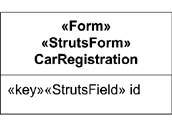Section 11.2. Stereotypes
11.2. StereotypesStereotypes modify the intent of the elements to which they apply. They allow the differentiation of roles of an element within the model. For example, you can quickly differentiate classes stereotyped as Controller as having a different role in the system than those stereotyped as View. Visually, UML allows graphical and textual representation of a stereotype. Graphics and text can be combined in various ways for node-type elements, as shown in Figure 11-3. The four elements that you see going across the top of the figure all represent the same combination of Form and key stereotypes but in different ways. Edge-type elements have only a textual representation, and thus you see «depends» on the dependency between Billing and Inventory. Figure 11-3. Various representations of stereotypes When displayed as text, a stereotype is enclosed in guillemots («»), as in «MyStereotype». Because the guillemots require an extended character set to display correctly, you may also use double angle brackets to show a stereotype in 7-bit ASCII, as in <<MyStereotype>>. Graphical icons are neither defined nor standardized by UML. You can expect toolmakers to extend the graphics differently, including coloring or shading, at their discretion. Avoid graphical symbols for interchange of models between different tools. However, within the controlled environment of a compatible set of tools, specialized graphics and/or colors will likely have more visual impact.
You can tag an item in a UML model with more than one stereotype. Figure 11-4 shows multiple stereotypes as a list, with each stereotype enclosed in «guillemots». Figure 11-4. A class and an attribute, with two stereotypes each |
EAN: 2147483647
Pages: 132
